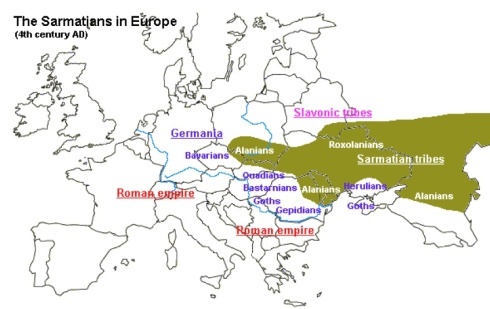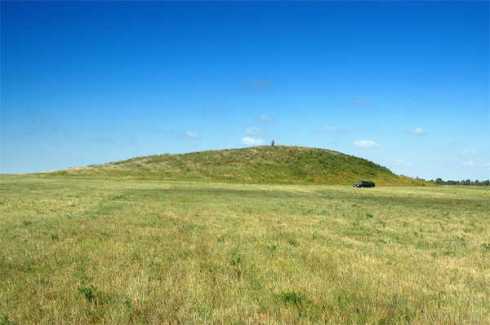You are currently browsing the tag archive for the ‘warriors’ tag.
The Scythians, the wild horse-mounted warriors of the Steppes, sometimes ride onto these pages and off again, back into the billowing mists of Central Asian history. Their name straddles myth and reality: the Scyths were there at the fall of the tower of Babel. They were the children of Echidna and Hercules. They lived in a swath of land somewhere from Romania to Korea in a swath of time from 800 BC to 300AD. They were Europeans with pale skin and blue eyes or Asians with dark slanted eyes. They were fighters, shamans, traders, slavers, and peerless artisans. To Greeks they were the opposite of Greeks. To the Chinese they were the opposite of Chinese.
But really who were the Scythians? Well we don’t exactly know. We have some partial answers to some of these questions, but “Scythian” was a word that was used in classical antiquity the same way we use “Gothic” today (indeed–the last Scythians, who played such a role in the histories written by Byzantine historians from the 2nd through the 5th centuries AD were literally Goths). The word denoted an outlander from the steppes—an ideal of living rather than an ethnicity. Upon the Steppes, in the land the Greeks called Scythia, there were indeed pastoral tribes of equestrian herdsmen (who sometimes turned to war and plunder when circumstances were unusually bad or unusually good) but since they did not write it is difficult to untangle their history. This society was made up of confederated tribes–which tended to specialize at different tasks (herdsmen, ploughmen, smiths, etc.). However above the other tribes were the warrior elites, the royal Scyths, who according to Herodotus, regarded the other tribes as little more than slaves. These closely allied elites were formidable warriors. Without stirrup or saddle they rode horses to battle: even while mounted bareback they fought with composite bows laminated together from horn, hood, and sinew.
The ruling Scythian warriors, or Royal Dahae, were inhumed in spectacular kurgans along with great hordes of treasure. Much of what we know about the Scythians comes from these archaeological finds (and the rest mostly comes from Herodotus who was probably making a lot of it up). A kurgan consisted of a great mound of earth over a central tomb constructed of sacred larchwood. Animal or human sacrifices were draped over the outside of the tomb. Inside the warrior elite lay in state with hordes of treasure. Some of the most spectacular treasures known come from Scythian graves (which definitely deserve their own posting) and consist of golden statues depicting sacred creatures like lions, antlered reindeer, and gryphons. Kurgan tombs of the Scythian warrior elite contained weapons, armour, sumptuous clothing (woven of silk, gold, and hemp) and bowls of coriander seeds and cannabis–which was used in purification rituals and shamanistic rites.
Although the Ancient Greeks might have looked down on the Scythians, numerous modern groups have claimed to be their direct descendants. Among the peoples who have claimed or currently claim Scythian blood and heritage are the Ossetians, Pashtuns, Jats, Parthians, Poles, Picts, Gaels, Hungarians, Serbs, Croats, Scots, Slavs, Anglo-Saxons, and sundry Germans. Like all such ancestral claims, many of these are disputed by scholars, nationalists, rivals and so forth (although Slavic people most certainly have Scythian ties). Being American, I am inclined to think that anybody who wants to claim a particular ethnicity or heritage is welcome to do so, but perhaps that is my mixed Scythian blood talking!
To celebrate the spooky season, we have been recounting the various fates of the brood of monsters descended from Echidna. While doing so, one aspect of the story has become glaringly apparent: more than half of the family of monsters was defeated by Hercules. Cerberus, Ladon, Orthrus, the Nemean Lion, the Hydra, the great Caucasian Eagle…the demigod bested them all as he bludgeoned and ripped his shining path through the world. (I haven’t told the tale of Orthrus, the two headed dog who was best friend to the three-headed monster Geryon: suffice to say, during his tenth labor, Hercules killed the poor pooch.) One would expect a devoted mother to be enraged and thirst for vengeance. However there is a story about Hercules and Echidna meeting, and it seems the mother of monsters desired something very different from revenge. I’ll turn the storytelling over to Herodotus. It is worth remembering that while people call Herodotus “the father of history”, historians call him “the father of lies”. He tells a great many thrilling stories but he probably made them up while he was binge drinking in his library…. Anyway, here is the passage from Book IV of the Histories of Herodotus (translated by George Rawlinson):
Hercules came from thence into the region now called Scythia, and, being overtaken by storm and frost, drew his lion’s skin about him, and fell fast asleep. While he slept, his mares, which he had loosed from his chariot to graze, by some wonderful chance disappeared. On waking, he went in quest of them, and, after wandering over the whole country, came at last to the district called “the Woodland,” where he found in a cave a strange being, between a maiden and a serpent, whose form from the waist upwards was like that of a woman, while all below was like a snake. He looked at her wonderingly; but nevertheless inquired, whether she had chanced to see his strayed mares anywhere. She answered him, “Yes, and they were now in her keeping; but never would she consent to give them back, unless he took her for his mistress.” So Hercules, to get his mares back, agreed; but afterwards she put him off and delayed restoring the mares, since she wished to keep him with her as long as possible. He, on the other hand, was only anxious to secure them and to get away. At last, when she gave them up, she said to him, “When thy mares strayed hither, it was I who saved them for thee: now thou hast paid their salvage; for lo! I bear in my womb three sons of thine. Tell me therefore when thy sons grow up, what must I do with them? Wouldst thou wish that I should settle them here in this land, whereof I am mistress, or shall I send them to thee?” Thus questioned, they say, Hercules answered, “When the lads have grown to manhood, do thus, and assuredly thou wilt not err. Watch them, and when thou seest one of them bend this bow as I now bend it, and gird himself with this girdle thus, choose him to remain in the land. Those who fail in the trial, send away. Thus wilt thou at once please thyself and obey me.”
Two of Echidna’s human children by Hercules proved to be disappointments and were sent away, but Skythes, the youngest son was indeed capable of wielding Hercules’ bow. Skythes stayed in the land, became its king, and fathered the race of the Scythians, a (real) tribe of people whom the ancient Greeks regarded as being descended from union of the the greatest Greek hero and a primordial monster! People who are familiar with the Scythians will be yelling and punching the air right now (because Scythians are just completely awesome), however, to quickly summarize; the fearsome Scythians were nomads of the Pontic-Caspian steppe. They were renowned for their formidable prowess at mounted warfare and for being general badasses. Roman historians described the Goths as Scythians. The Scottish even called themselves Scythians! in the 1320 Declaration of Arbroath, an open letter to the pope, the elite aristocrats of Scotland claim Scythia as their former homeland. It goes without saying they were binge-drinking in a library when they wrote that puppy.
Speaking of puppies, tomorrow, we wrap up this series with everyone’s favorite child of Echidna…


















